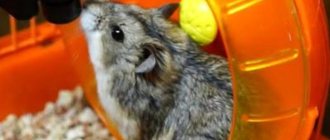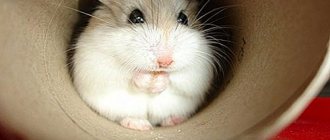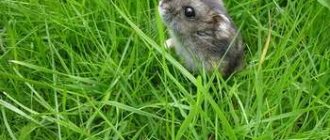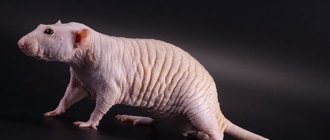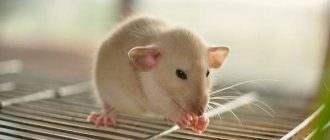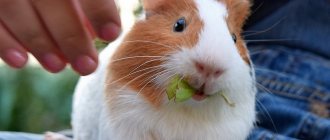- Wild animals
- >>
- Mammals
The Djungarian hamster is a small, very cute and active animal from the rodent family. They are very common as pets. Their popularity is explained by their simplicity and low maintenance requirements. However, before you bring such a small animal home, you need to ask how to properly create comfortable living conditions for it. In many literary sources, the dzhungarik is found under the name Sungur hamster.
Origin of the species and description
Photo: Djungarian hamster
Djungarian hamsters are chordates. They are classified into the class of mammals, the order of rodents, the family of hamsters, the genus of hairy-footed hamsters, and the species Djungarian hamster. The first scientific description of hamsters was compiled in 1839 by researcher Waterhouse. At that time, these representatives of the hamster family were present in single specimens only in the territory of modern Syria.
Almost a hundred years will pass until the first living hamster falls into the hands of scientists and researchers. The first person to catch the rodent was the scientist and researcher Aharoni from Jerusalem. He managed to find a female specimen in a deep hole along with 12 cubs.
Video: Djungarian hamster
After transporting the animals, only four were able to survive. Very soon, offspring appeared from these animals, which also began to multiply and produce offspring quite quickly. It was these individuals, discovered by the professor in a deep hole, that became the ancestors of all animals kept at home.
In 1938, the animals were brought from England to the United States. Here they were used as animals for laboratory research. Then they returned to Europe as laboratory animals. From this point on, the rapid and highly successful domestication of animals began. Within about a decade, hamsters have completely become pets in many countries around the world.
Owner reviews
According to experts, it is not recommended to keep more than one hamster in one cage, although many owners practice keeping “married couples” in one cage. Moreover, such content does not have any negative consequences. Domestic rodents quickly get used to the hands of their owner. With a lack of attention, on the contrary, the animal quickly loses the habit, which leads to aggression towards its owner. If a Djungarian hamster appears in the house, then it will not be superfluous to make sure that it pleases all family members for as long as possible. To do this, you will have to direct all efforts to ensure that the animal always remains healthy and cheerful. It is very important that the animal eats exclusively what is healthy for it and does not eat junk food in the form of sweet, salty and other unhealthy foods. If signs of illness appear, you should not determine the type of illness yourself. In this case, only a specialist can make the correct diagnosis.
Disadvantages of keeping a hamster. The whole truth about Djungarian hamsters
Appearance and features
Photo: What a Djungarian hamster looks like
Djungarian hamsters are very cute small animals that have a pointed muzzle and small, round ears. Sexual dimorphism is practically not expressed. One adult, regardless of gender, has a body length of 9-10 centimeters. The body weight of one adult individual is about 35-65 grams. The animal's muzzle is slightly elongated, pointed at the nose. Hamsters' eyes are round, black, and shiny. The nose area is framed by a rather long mustache.
Hamsters' fur is quite thick and can be colored in a variety of colors. The body of rodents is painted in two colors. The upper part of the body in the back area has a darker color. The paws and belly area are colored light, milky or beige. A characteristic feature is the presence of a dark stripe that runs along the line of the animal’s spine.
Possible color options for rodents:
- grey;
- brownish;
- gray with a lilac tint;
- ginger;
- cream.
Under natural conditions, hamsters shed twice a year. In winter, their coat is white with a silver tint, and in summer it turns gray for camouflage purposes. Hamsters have small, four-toed feet. They perform the function of hands. The fingers have long, sharp claws that help animals when digging holes. The animals' fingers are covered with thick fur. Djungarian hamsters have a thin, short tail.
Choosing a house for a dzhungarik
It is most convenient to keep and care for a Djungarian hamster in:
- cage
- dune
- large aquarium (with good ventilation)
- terrarium
- rack
Let's look at each option in a little more detail.
Cell
A cage is one of the most convenient homes for keeping a hamster. Most importantly, when purchasing, pay attention to the following points:
- The pallet is preferably plastic. Wooden is chewed, and it absorbs odors.
- For ease of maintenance, it is better to take it with a removable tray.
- Choose higher plastic sides: less filler will fly out of the cage.
- The rods must be metal (again, so as not to be chewed).
- Choose a cage with small distances between the bars. Djungarians are so small that they crawl between them, and it is impossible to keep them in such a house.
- The recommended bottom size for one animal is approximately 30x50 cm.
- Inspect the entire structure: there should be no burrs, sharp edges or protruding ends of the wire anywhere. The baby is easy to hurt.
Dune
Dunes for keeping rodents are becoming increasingly popular. And for good reason. The advantages of such houses:
- the sides are solid: no matter what games the Djungarians play, there will be no filler on the floor;
- even the smartest hamster will not be able to open the door in the “ceiling”;
- the upper part is transparent, you can clearly see what the animals are doing;
- small dunes can be used as portages;
- very easy to clean thanks to its simple and well-thought-out design.
There are also mixed options for keeping, which can be called “cage dunes”. Typically in these dunes, more sections of metal cage are inserted between the tray and the lid. This way you can increase the height and provide ventilation.
You can buy ready-made houses of any variety here (there are both budget options and luxury “villas” for keeping a pet).
Dune, cell and their hybrid.
Aquarium
Keeping hamsters in an aquarium is not recommended. The fact is that they are usually narrow and poorly ventilated. In addition, if the aquarium is glued together and not solid, poisoning from the glue is possible (rodents taste everything).
The advantage of keeping it in an aquarium is that you can clearly see how your pet plays. Children especially appreciate this. If you buy an aquarium that does not contain harmful substances and provide a flow of fresh air (forced ventilation), then there will be no harm to your Djungarian pet.
Terrariums and glass shelving
This is a good option for keeping (subject to a minimum bottom size of 30x50 cm). Everything is visible, very spacious and (in the case of shelving) takes up little space. The only drawback is that care is not very convenient. An excellent choice for breeding Djungarian hamsters, but for one individual there is probably no point in such a large house.
Houses made from scrap materials
Based on the size requirements (30x50 for one rodent) and ventilation, tiny options such as a jar or cardboard box are immediately eliminated: high-quality care and maintenance of a Djungarian hamster in them is impossible. Otherwise, complete freedom for your ideas. The main thing is to ensure sufficient size and air flow.
Not that I'm complaining, but isn't there something bigger?
Where does the Djungarian hamster live?
Photo: Djungarian hamster in Russia
The natural habitat of the dwarfs is quite wide. Djungarian hamsters are named after a province in the northwestern region of the People's Republic of China - Dzungaria.
Geographical regions of animal habitat:
- desert regions of Russia;
- Altai region;
- Kazakhstan;
- Mongolia;
- China;
- Korea.
The animals live in minks. The burrows are dug and arranged independently. Each burrow has from 3 to 6 entrances and exits. The structure of hamster burrows resembles real chambers, the depth of which is about one meter. The rodent has a pantry room where it prepares food supplies for the winter, a bedroom, and a latrine.
To keep an animal in artificial conditions, you will need a cage, which must be equipped with everything you need to keep a hamster comfortable. A wheel with a diameter of at least 16 centimeters must be placed in the cage. A wheel with a small diameter leads to spinal deformation. Another mandatory element is a house. It is better if it does not have large window openings to avoid an animal with cheeks full of food getting stuck in it.
It is necessary to put branches of fruit trees and shrubs in the cage, on which the hamster will sharpen his teeth. You need to designate a toilet for him in some corner. From time to time it is recommended to place a container in the cage into which sand can be poured for chinchillas. Djungarians will happily swim in the sand in this container. It is prohibited to place cotton wool, hay, or various scraps of fabric into the animals’ homes. Long fibers can crush the limb. In this case, it dies.
Maintenance and nutrition
Pet cage
| Cell | Price |
| Ferplast Hamster Duo rodent cage | RUB 3,800 |
| Criceti 9 Princess 9 for hamsters 46×29.5×23 cm | RUR 1,851 |
| Ferplast Ferplast Olimpia 46×29.5×54 cm | RUR 4,355 |
| TRIOL Triol YD415 340x280x250 mm | RUB 1,137 |
| TRIOL Triol 1403 580x320x320 mm | RUB 2,314 |
Despite the modest size of the animal, the cage should be relatively large. The minimum dimensions are 55x30 cm. In some cases, in order to avoid unnecessary injuries, a single-tier cage is recommended. Instead of the usual version of rods, you should pay attention to cage options with plastic inserts and closed dunes.
At home, unfortunately, Djungarians can only survive in a cage because they are very picky about food and external conditions, this is not a Roborovsky hamster, which can also fight back!
The presence of pipes and various tunnels, labyrinths and passages will help the animal quickly feel the homely atmosphere. Indeed, in nature, hamsters constantly dig labyrinths and tunnels for themselves: this is important for them in terms of life and personal safety.
The cage should be in a quiet place, protected from drafts and direct sunlight. A house in a cage must be provided for the animal’s privacy. For the Dzungarian species, the optimal size of the house is 10 cm. You can purchase the simplest design without windows and bottom.
A thick layer of filler is poured onto the bottom of the cage: the thicker it is, the better for the rodent. You should choose cellulose or corn options. Rags, napkins or paper towels will help your hamster build his nest. It is important that the fabric is white, without dyes.
The main equipment for the cage are the following household items:
- A house where he can easily escape if he needs privacy.
- Lazy. They can be of various shapes and heights so that the rodent does not get bored.
- A specialized toilet designed for small rodents.
- Bedding made of compressed sawdust.
- A drinking bowl with a volume of at least 50 ml. It is best to purchase an automatic water supply option.
- Place of animal hygiene in which sand must be poured. It must be dry and clean.
An alternative to a standard cage, in the case of Djungarian hamsters, can be an aquarium. Narrow containers for keeping rodents are not suitable due to poor ventilation, so you need to choose the standard rectangular option. Otherwise, bacteria that are harmful to the animal may multiply in the aquarium.
Pet sports area
To maintain an optimal level of health, the animal needs to cover a distance of 10 km per day. You can help your animal maintain this activity using a running wheel. The diameter for a dwarf rodent should not be less than 16 cm. There should be no crossbars, and the distance between the rods should be such that the pet’s paws do not fall into it when running.
In addition to the wheel, a number of owners purchase balls for walking. With its help, your pet can calmly walk around the apartment without touching wires or chewing furniture. Additional devices can include labyrinths, tunnels and obstacle courses.
Eating area
The best option for a rodent feeder would be a deep metal container. It will not roll over and is easy to clean. In the case of a closed feeder, it is hung on the walls or bars of the cage.
Additional accessories
Sometimes a carrier cage may be needed. The hamster can also be placed in it when cleaning the cage.
It is better to feed animals in the evening, when they begin to become active. The drinking bowl in the cage needs to be changed regularly. Spot cleaning should be done daily. This procedure includes changing the filler, as well as yesterday’s food with fresh food.
Hamsters themselves organize a toilet using fresh litter; they are quite clean.
Despite the need to maintain cleanliness, spring cleaning is stressful for a hamster. Therefore, washing the cage should not be done more than once a week. Washing should be done with a clean sponge and fragrance-free soap. It is important to treat all accessories during cleaning and then wipe dry. The drinking bowl also needs to be disassembled and washed thoroughly.
Cage cleaning should be carried out according to schedule. Even if the cage is heavily contaminated, chemicals should be avoided. In order to remove stains from waste residues, you can use vinegar, applying it to the epicenter of contamination for 15-20 minutes, then remove it with a damp cloth.
Hamsters are very sensitive animals. Especially their psyche can be shaken by general cleaning of the food reserves that they are actively creating. Cleaning too often can lead to stress for the animal. Therefore, you can reduce the risk of psychological trauma by removing only spoiled varieties of food.
Communication process
Djungarian hamsters are independent and rarely make contact with their owner on their own. Some individuals may begin to bite the owner while attempting contact. You need to accustom your animal to handling gradually, with less stress for both parties. Don't expect too quick results. If there is no progress, you need to contact a veterinarian; perhaps, communication with a person is physically unpleasant due to the animal’s hidden ailments.
It is also worth remembering that if there is no contact with the pet for 1-2 weeks, it will go wild again and you will have to start the procedure again.
The hamster is a nocturnal animal, so during the daytime it is lethargic and passive. But in the early evening you can accustom the animal to communication. Some individuals are given basic training. In order for the owner to sleep comfortably at night, you can use earplugs, or slightly adapt your regime to suit your pet.
Where is the best place to keep it?
The Djungarian hamster must be kept in a spacious cage: the animal is quite mobile and needs a lot of space to play. If the cage is too cramped, the hamster will be in a constant state of stress, which will lead to illness and early death.
The cage for Djungarian hamsters must meet the following requirements:
- the cage bars should not be galvanized; its dimensions should be at least 30 by 50 centimeters. If there is no cage, the hamster can be kept in a spacious aquarium. The aquarium must have low walls, otherwise, due to poor air ventilation and dampness, colonies of bacteria and fungi will appear in it, which will affect the health of the hamster;
- sand or small sawdust are suitable as bedding. Cotton wool, newspapers and scraps of fabric should not be placed on the floor of the cage: they can harm the health of the animal. Particles of thread and cotton can get into the respiratory tract and cause irritation, and newspapers are printed using toxic inks;
- the cage should contain branches, large roots and other objects that the Djungarian hamster can climb;
- in nature, Djungarian hamsters live in burrows, so the animal must have a house that can be attached to the wall of the cage;
- the cage must be equipped with a running wheel, the diameter of which depends on the size of the hamster;
- The cage must be equipped with a drinking bowl with a volume of 50 ml. The water in the drinking bowl is changed daily. It is necessary to ensure that mold does not appear on the walls of the drinking bowl;
- The cage feeder is selected depending on the size of the pet. Its length can range from 3 to 8-9 centimeters. The feeder should be stable and not too deep.
Additionally, you can buy a bathing suit for fine sand, in which the hamster will clean its fur.
It is important that your hamster always has a chalk stone in his cage to wear down his teeth. You can replace the chalk stone with a small birch block.
Djungarians have a high chance of developing diabetes, so their diet should not contain foods rich in sugars (honey, fruits, vegetables).
Communication
Djungarian hamsters communicate with their owners very willingly. They quickly get used to being handled and rarely show aggression. In order for the pet to trust its owner more, immediately after purchasing a Djungarian hamster, you need to pick it up more often and talk to it in a quiet, calm voice.
When adapting a hamster to new living conditions after purchase, you should touch it only with thoroughly washed hands, which are not covered with cream or eau de toilette. This will allow the animal to quickly get used to the natural smell of the owner. In addition, the strong smell of cosmetics can cause allergies in the Djungarian hamster.
Nutrition
Diet
Grain mixtures often serve as the basis of the diet. Animals have a well-developed metabolism, so they need a sufficient amount of food. In order to maintain your pet’s health at the required level, it is important to purchase food from trusted manufacturers. Fresh vegetables and occasionally protein foods will help diversify the diet.
The myth that hamsters eat everything is fundamentally false . Before creating an animal’s diet, you should study the list of permitted and prohibited foods.
Diet
| Name of food | Price |
| VERSELE-LAGA Crispy | 239 RUR |
| Brava grain mixture with fruits and vegetables | 55 RUR |
| Treat for rodents Prestige | RUR 219 |
| FIORY Criceti for hamsters | RUR 233 |
| Mr.Alex Assorted cereal stick | 82 RUR |
| Mr.alex вasic Buckwheat | 129 RUR |
| Padovan Food Padovan Grandmix criceti | RUR 322 |
| Fiory Fiory food for hamsters Classic | RUR 184 |
The basis of the diet should be balanced dry food for Djungarian hamsters. Additionally you can give :
- seeds and nuts (except almonds);
- dried fruits;
- sprouted wheat grains (especially in the off-season to prevent vitamin deficiency);
- small amounts of fruits and vegetables.
Two to three times a week you should add protein foods to your diet: boiled egg whites, cottage cheese, boiled low-fat fish.
Sick hamsters and pregnant hamsters can be given baby food prepared in water.
Under no circumstances should you give your Djungarian hamster the following foods:
- spices (salt, pepper, sugar);
- sweets (chocolate, cookies, ice cream);
- citrus;
- mushrooms;
- sausages and sausages;
- branches of coniferous trees.
The hamster should be fed twice a day: morning and evening. The serving size depends on the animal’s needs, its age and activity. It is advisable that the food be a little more than the hamster needs.
Before adding fresh food, you need to remove any leftovers from the previous meal and thoroughly wash the feeder.
How many individuals are best kept in one cage?
You cannot keep several hamsters in one cage. In nature, Djungarian hamsters lead a solitary lifestyle, so they will perceive another individual on their territory as a competitor. When kept together, the animals will experience chronic stress, and during a fight they can seriously injure and even kill each other.
You can keep hamsters in the same cage only if they grew up together. However, even in this case, conflicts over territory may arise between two individuals.
What does the Djungarian hamster eat?
Photo: White Djungarian hamster
Djungarians are undemanding when it comes to nutrition, so keeping and feeding them will not be too expensive. This type of pet can safely be called omnivores. The best option for these animals is ready-made balanced types of food specifically for hamsters. The basis of these feeds are granules and grains and cereals. Hamster formulas also include pieces of corn, as well as at least 10-15% proteins.
Be sure to give your hamsters fresh, juicy vegetables and fruits, which the animals love very much. However, it is necessary to promptly remove unused remains and cells in order to avoid rotting and disease of the animals, since animals often not only eat the food allocated to them, but also hide large quantities of them in their cheeks. This is how they stock up on provisions.
The owner must ensure constant access to water. To do this, you can install sippy cups. Another mandatory condition is the introduction into the diet of vitamins and minerals necessary for the normal functioning of hamsters. The animals also need to be fed with fresh herbs and juicy berries. Sometimes it is recommended to give them nuts and sunflower seeds. Hamster breeders should be careful about the source of protein in their hamsters' diet.
It is recommended to give them the following ingredients as protein food:
- boiled chicken liver in small quantities;
- boiled chicken breast;
- low-fat varieties of cottage cheese.
Your hamster should have fresh food every day. Changing the water in the sippy cup is also required daily. It is strictly forbidden to include foods that contain large amounts of sugar in your diet.
Care
Frequent illnesses
The most common problem with Djungarian hamsters is injuries that the animal can receive when falling. When injured, you may notice that the hamster's paw is twisted or turned at an unnatural angle. From pain, the animal can fall into a state of shock: it is motionless and does not react to what is happening. An injury is a reason to take your hamster to the vet as soon as possible. Treatment depends on the condition of the animal and the severity of the injury.
Susceptible to respiratory viral infections. Infection is indicated by:
- decreased activity;
- sneeze;
- loss of appetite.
There is no special treatment for viral diseases in Djungarian hamsters. It is recommended to provide your pet with vitamin supplements and high-quality food to strengthen his body’s immune defense and speed up recovery.
Conjunctivitis
If your hamster cannot open his eyes and there is a small amount of pus on his eyelids, he may have developed conjunctivitis. It is recommended to treat conjunctivitis by washing the animal’s eyes with a weak saline solution. In order not to make a mistake in the concentration, you can buy saline solution with a sodium chloride concentration of 0.9% at the pharmacy.
Cataract
Cloudiness of the pupil indicates cataracts. This disease usually develops in older individuals. It is impossible to cure cataracts.
Long teeth
Refusal to eat may indicate a dental injury or that too long teeth are preventing you from eating. In such cases, the teeth should be straightened by contacting a veterinarian. To prevent excessive growth of incisors, you should constantly keep a chalk stone in the cage.
Dermatophytosis
Peeling skin and hair loss are a sign of eczema or dermatophytosis. Problems with the skin indicate either stress or the presence of an allergen in the cell. Treatment of eczema and dermatophytosis is carried out by a veterinarian.
Parasites
If your hamster is constantly itching, restless, and has red dots visible on its skin, it most likely has parasites (lice or fleas). On sale you can find many products designed to combat skin parasites in rodents. A veterinarian will help you choose the safest one for your animal.
Refusal to eat, diarrhea, and loud bowel movements are symptoms of an intestinal infection. They can be cured with antibiotics.
How to properly care?
It is enough to provide him with everything he needs (a spacious cage, food, a drinking bowl with fresh water). There are some subtleties that will create optimal conditions for the animal. To help your pet get used to its owner faster, it is recommended:
- talk to the animal in a quiet, calm voice;
- pick up the hamster delicately and gently, supporting it under the front paws;
- before touching the animal, give it the opportunity to sniff your hand: this way the animal will quickly get used to the owner’s smell.
It is important to clean the cage regularly. This should be done once every 7-10 days. The hamster is placed in a small carrier cage or cardboard box with holes for ventilation. The old filler is removed and replaced with a new one, leaving a small amount (to make the animal feel more comfortable). Once every 4 weeks it is necessary to wash the cage or aquarium with warm water and laundry soap.
How not to care
To avoid harming your hamster, you should:
- bathe your pet in soap and water. The hamster can handle cleaning its fur on its own. You can buy special sand for him for bathing guinea pigs. Sand is poured into the bathing suit and placed in the cage. After some time, the hamster begins to wallow in the sand and clean its skin;
- buy a “comrade”. Hamsters do not tolerate rivals and defend their territory. They only need a partner for reproduction; the rest of the time, dzhungarikas feel great alone. If the need to house two hamsters in one cage is great, you must first divide the cage into two halves using a partition. The partition can be removed only when the animals get used to each other and do not show signs of aggression;
- leave the hamster on a high surface. Rodents are lowland animals and do not understand what height is and its dangers. Dzungarik may fall and be seriously injured and even die.
In order for your hamster to quickly get used to it and trust its owners, you should not:
- make sudden movements near the animal;
- scream near the cage, play loud music;
- pick up a sleeping or recently awakened animal. This can frighten the hamster so much that it bites the owner, which is quite painful;
- roughly take an animal by the withers to lift it.
Features of character and lifestyle
Photo: Djungarian hamster
Djungarian hamsters tend to lead a solitary, solitary lifestyle. Under natural conditions, they live separately, in burrows that they dig and inhabit on their own. Rodents tend to be nocturnal. During the day they sleep almost all the time, hiding in their shelter. The shelter is left at nightfall. This way of life allows you to hide from a large number of enemies in natural habitats.
At night, hamsters are very mobile and active. In search of food in natural conditions they can travel quite long distances. A distinctive feature of these representatives of rodents is their thriftiness. Animals tend to collect food with their paws, like hands, and push it behind their cheeks. So they bring it home and put it in their storerooms.
Interesting fact: The size of the cheek space in which animals store their reserves can exceed the size of their heads by three times. It is noteworthy that before the onset of cold weather, hamsters can make an amount of reserves that exceeds their own body weight by almost a hundred times!
It is at night that animals are engaged in searching and collecting food and arranging their burrows. They also tend to frolic, just run and play. That is why, when arranging a cage for keeping at home, it is very important to install a wheel, swings, etc.
Typically, each individual has its own habitat region, and the territories of different individuals do not overlap. In a situation where this does happen, individuals reclaim their territory from each other. Often such wars lead to the death of the weaker animal.
Habitat
The Djungarian hamster is native to Central Asia. It received this name in honor of the Chinese province, which is located in the northwestern part of the country. Rodents prefer to inhabit desert and steppe areas; they are less often found in forest-steppes.
The homeland of Djungarian hamsters is a relative concept, since their habitat is quite wide. This species is found in Siberia, Kazakhstan, Mongolia and some regions of China.
In Russia, these rodents inhabit the southern regions of Transbaikalia, Tuva, and some parts of Western Siberia. The species is distributed in the Chui and Aginsk steppes and in the mountainous areas of Altai.
Social structure and reproduction
Photo: Djungarian hamster in nature
Djungarian hamsters are highly fertile. This is how nature intended it so that the animals would not hatch in their natural habitat. Hamsters reach sexual maturity at four weeks of age. If the animals are kept at home, they should be separated from each other as soon as they are one month old. Early pregnancy is very dangerous for the life and health of females.
The most optimal age for the first pregnancy is 3.5-4 months. After mating at home, individuals of different sexes are recommended to be separated so that they cannot harm each other. Pregnancy lasts on average 23-24 days. One female can give birth to from 1 to 10 cubs. Babies are born completely helpless and are in great need of maternal help and care. Sometimes it happens that the female abandons her offspring, or may even eat her cubs.
Interesting fact: A day after the birth of her offspring, the female is again ready to mate.
Hamsters get stronger and grow quite quickly. To get healthy offspring, it is recommended to choose healthy individuals with a known pedigree for mating. Only in this case is there a guarantee that the animal will not have any pathological diseases.
Cost of Djungarian hamsters
When buying a Djungarian hamster, it is advisable to pay attention to factors such as:
- Pet's age. The hamster should be about 5-6 weeks old.
- Character of behavior. The animal should not be too apathetic and lethargic, or overly excited or nervous.
- Health. His state of health visually should not raise the slightest doubt.
- Wool cover. It should be dry and clean, without signs of bald spots or mechanical damage.
- The condition of the eyes, which should be clean, without traces of various discharges.
- The condition of the nasal cavity, which also should not have traces of various secretions.
- The condition of the fur around the anus should be characterized as clean and dry.
If a person has little experience, then it is quite difficult to distinguish the sex of very young individuals. This is true even for breeders. It is better to know for yourself how to distinguish a male from a female. Similar animals can be bought for 250-350 rubles, regardless of gender. If hamsters have a rather rare color, then the cost of such individuals is slightly higher.
Natural enemies of Djungarian hamsters
Photo: What a Djungarian hamster looks like
In their natural habitat, hamsters have a huge number of enemies who constantly hunt them. The nocturnal lifestyle and deep burrows save rodents from some of them.
Natural enemies of hamsters:
- predatory bird species - stoats, owls, hawks, falcons;
- ferrets;
- wild dogs;
- foxes;
- wolves;
- lynx;
- wild cats;
- martens.
Nature has endowed these representatives of the rodent family with excellent hearing, which allows them to detect the slightest rustle at a considerable distance. This ability allows you to determine the approach of an enemy in many situations. If a hamster hears dangerous sounds, it instantly flees. They most often hide in deep holes or other reliable shelters. If the sounds that instill fear are very close and there is no way to escape, the animal simply freezes, wanting to remain unnoticed. If this maneuver does not bring the desired result, the hamster rushes to attack.
In some cases, even large predators are confused by this behavior, giving the small animal a chance to escape. There are a number of diseases to which hamsters are very sensitive. Among the most common diseases that cause death in animals are diabetes and obesity.
Unsociable friends
Djungarian hamsters have an independent character, so they are not very eager to communicate with their owners. In some cases, an agitated “fluffy” may even bite the hand that feeds him. To wean a pet from such a habit, it must be raised every day, taking it into your arms. But raising a pet once and for all will not work. If you don’t communicate with him for 7-10 days, he will become “wild” again, and you will have to start the educational process all over again.
To prevent your furry neighbor from biting, you should not take him out of the house during the daytime nap, you should not put him head down, or drive him into a corner.
Other interesting anatomical features of funny rodents
Dentofacial apparatus
The number of teeth in a hamster is 16 (8 on the upper jaw and 8 on the lower, with the number of incisors being 2 each on the upper and lower jaws, and the number of molars being 6 each). Incisors do not have roots, due to which they have the ability to grow throughout the life of the animal. These teeth are covered with yellow enamel, which prevents excessive wear of the incisors.
Lateral glands for marking territory
Like many other animals, hamsters have special organs that secrete a special secretion. These organs in a hamster are the lateral glands, located on the back behind the ears and representing two inconspicuous black dots. The secret secreted by this organ allows the hamster in the wild to mark its territory and participate in the race for females.
Normal body temperature
The body temperature of a healthy hamster is 37.5–38.5°C. Any deviation upward or downward indicates the presence of an infectious disease. The indicator is measured rectally. If the temperature is elevated, the animal should be placed for some time near a source of cooling - near the refrigerator or on the windowsill.
Also learn about what hamsters eat.
If the degrees drop, use a heating pad: fill it with warm water, wrap it in a towel and place it next to the animal. In any case, do not delay your visit to the veterinarian, as infectious diseases can be fatal.
Features of the sense organs of hamsters
Vision
Are the hamster's eyes, like those of other rodents, located on both sides of the head? which provides a wider viewing angle. This feature of the hamster’s head anatomy significantly eliminates its myopia. It is worth noting the peculiarity that the light sensitivity of the eyes is much higher than that of a person, so keeping a hamster on a windowsill or in a bright room without the use of a darkening cape is not recommended.
Contrary to popular myth, hamsters are not colorblind. The range of color perceptions of this rodent ranges from light yellow to dark blue.
Hearing
The hamster's ears are quite mobile. Hearing is more acute than that of humans. In addition, this species of mammal is capable of detecting ultrasound.
Smell
Like many other rodent species, the hamster receives most of its information about the world around it through its sense of smell. The main role in the sense of smell of hamsters, as well as in the sense of smell of many other animals (dogs, cats), is played by whiskers - whiskers. With their help, hamsters navigate in burrows and find food.
What does a hamster look like?
The family includes small, tightly built animals with short but developed body parts.
The body length of hamsters depends on the specific species and sex and can be from 7 to 35 cm. The length of the tail usually does not exceed 10 cm. Sexual dimorphism in size is widespread in hamsters (females are often larger than males). The back color varies from off-white to brown, and the belly color ranges from white to black. You can find individuals with a pronounced black stripe running across the entire back. Some species of hamsters have distinct pouches for carrying food.
In this article we will take a closer look at the physiology of the most popular hamster species. Interesting? Read on!
